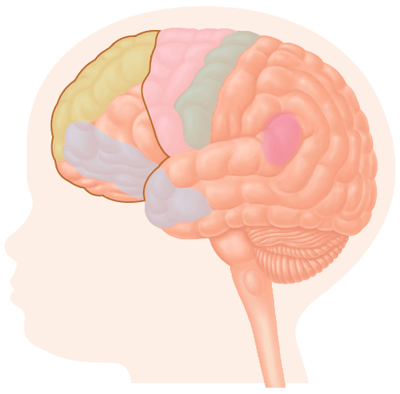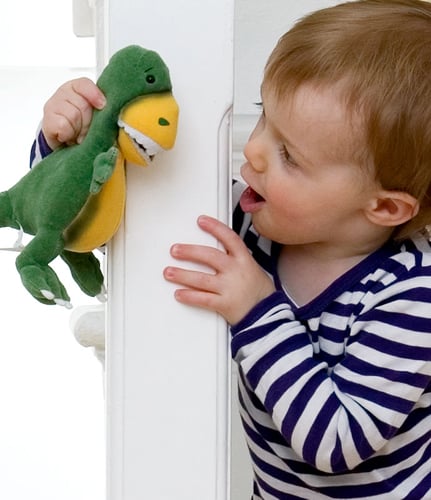A big priority for your toddler during months 18–24
will be multisensory development. Sights, sounds, smells, and textures
all contribute to the hands-on experience that will develop memory and
help children remember things far more effectively than simply by
telling them.
Your toddler’s brain
will continue to develop during months 18–24 in much the same way as it
did during months 12–18, but the impact will be more dramatic, as the
information embedded in her brain accumulates, and her memory gradually
increases. Chemical and neurological changes
that take place during brain development will continue as she gets
older. All areas of the brain will continue to develop during the next
six months (and into puberty). During this time you will notice an
increase in your toddler’s ability to reason, remember, pay attention,
and respond. Each time she listens and speaks, she is developing her
language ability. Although we take it for granted, talking is a highly
complex skill that requires many areas of the brain to function
together.
Language and movement
Gross motor and language areas develop connections rapidly to
improve coordination and develop speech. Fine motor skills mature later.

Gaining knowledge
Through experiencing many different sights, sounds, and objects,
he builds a rich tapestry of information, which gives meaning to words
and develops memory.

Learning to speak
To use language
effectively, we need to be able to produce it—by speaking, and also to
understand it—by listening and comprehending. These skills develop in
tandem, but are processed via different areas of the brain. Speaking and
understanding rely heavily on memory and are closely linked to the
ongoing development of the thinking and reasoning areas and the memory
centers of the brain.
The memory centers
are believed to hold information about the meaning of words and objects
based on physical description, personal experience, and connections to
other words and meanings. The memory centers influence which words we
know, select, and use. They link to the speech areas to influence the
way we produce and understand language. The thinking and reasoning areas
of the brain influence our attention and when and where we speak. The
emotional and social behavior area is involved in decoding the language
and gestures of others and influences our feelings and what we say.
When your toddler wants to
say something, her brain will speed rapidly through a series of
processes to see whether her memory has what it needs to communicate the
information. She cannot yet think consciously, in the way that an adult
can; but she can pay attention to what it is she wants to describe
(what does it look like?). She will then visually process the image in
her brain and the information it gives her (does it look familiar?).
Next she will instruct her brain to assess the meaning of it (does she
recognize it? What does it represent?) before assessing whether she has a
word or words to describe it.
For example, if your
toddler is looking at a large animal with four legs, her brain will try
to figure out whether it matches any of the mental images stored in her
brain. She then has to find the part of her brain which has stored the
necessary word and can remind her how to say it out loud. To form the
words, she will then shape her tongue and vocal cords, and pronounce it
accurately, sound by sound. She may then look at you, point, smile, and
say, triumphantly, “Big dog.”
Learning to understand
The brain uses a
different sequence to listen to and understand spoken language. As well
as using the ears to hear the sounds and interpret the literal meaning of the spoken words, the eyes and other senses are also used to decipher the social meaning
of what has been said, by decoding information about the speaker
(gender, age, tone of voice) and the context (familiar, dangerous, new,
interesting, hostile) and so on. The words are decoded as they are
spoken, and matched against a memory of stored words and meanings.
Hearing skills are used to gain contextual clues about the meaning of
the words and lipreading also plays a part (and is of great importance
for children who have hearing difficulties).
Using the example provided under the section Learning to speak,
when you receive the information “big” and “dog” that your toddler has
given you, you will be able to look at the picture and from the context
and your larger memory bank may see that the picture is, in fact, of a
horse. Your toddler describes it as a big dog, because it comes close to
the “dog” she has in her mind and she hasn’t learned the word “horse”
yet. Smile at your toddler and say, “Well, it does have four legs, and
it is very big, but it is too big to be a dog. It is an animal called a
horse.” When you correct your toddler, she will be able to store new
information for the future. Point out the horse’s mane and its long legs
and face; describe the sounds that the horse makes (“neigh”/“clip
clop”), and compare it with the dog’s “woof.” She will watch your mouth
as you shape the words, look at the picture as you describe it, and hear
the new sounds. All of this data is absorbed by your toddler’s brain
and stored for future use.
Your toddler’s language
and understanding will become both more specific and also more general
as usage and personal experience increases. For example, she will begin
to make associations, such as, “Patch is Grandma’s dog. He is white with
brown spots,” and “Dogs are pets. They are usually friendly. But I
should not pet dogs I don’t know.”
Left brain/right brain
The brain is divided into
two hemispheres. Although they work in partnership, they are newly
formed and immature in young children.
In the majority of people,
the left brain (which controls the right side of the body) is great at
logical thought: it governs understanding and language. The right brain
(which controls the left side of the body) is more instinctive and
creative: it picks up nonverbal cues and is more closely linked with the
responses of the physical body. The two sides are linked by a network
of nerve fibers that is the bridge via which words are delivered. Words
to describe a feeling travel in one direction (from left to right); and
the information about what that feeling represents and how to respond to
it travels in the other direction (from right to left). As this bridge
strengthens, emotional understanding and sensitivity develops. These
connections are immature in young children and coordinated thinking is
difficult, hence they shift rapidly between appearing calm one moment
and emotional the next. As the connections gradually strengthen, the logical, rational left brain will start to communicate better with
the emotional, instinctive right brain and a child develops more
balanced responses.